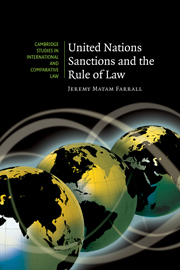Book contents
- Frontmatter
- Contents
- Extended Table of Contents
- Preface
- Abbreviations
- Part I Setting the scene
- Part II The evolution of the UN sanctions framework
- Part III UN sanctions in practice
- Part IV Strengthening the rule of law
- Appendix 1 Summary of policy recommendations
- Appendix 2 Summaries of UN sanctions regimes
- Appendix 3 Tables
- Bibliography
- Index
- Cambridge Studies in International and Comparative Law
Appendix 2 - Summaries of UN sanctions regimes
Published online by Cambridge University Press: 26 June 2009
- Frontmatter
- Contents
- Extended Table of Contents
- Preface
- Abbreviations
- Part I Setting the scene
- Part II The evolution of the UN sanctions framework
- Part III UN sanctions in practice
- Part IV Strengthening the rule of law
- Appendix 1 Summary of policy recommendations
- Appendix 2 Summaries of UN sanctions regimes
- Appendix 3 Tables
- Bibliography
- Index
- Cambridge Studies in International and Comparative Law
Summary
The following summaries trace the anatomy of each sanctions regime established by the Security Council, surveying the Council's decision-making with respect to each regime. Each summary outlines the constitutional basis for the application of sanctions, the objective(s) of the sanctions and the scope of the regime. The summaries also outline the manner in which the Security Council has bestowed responsibility upon other actors for the administration and monitoring of sanctions. Where relevant, summaries note any action taken by the Council to suspend or terminate sanctions. Each summary concludes by surveying the most notable aspects of that particular sanctions regime.
THE 232 SOUTHERN RHODESIA SANCTIONS REGIME
The Security Council established its first mandatory non-military sanctions regime in December 1966, imposing a range of measures against the white minority regime that had taken control of Southern Rhodesia in November 1965. The major objectives of the 232 sanctions regime were to end the reign of the illegal minority Southern Rhodesian regime and to enable the self-determination and independence of the Southern Rhodesian people. The regime initially consisted of a range of targeted trade sanctions, but it was subsequently expanded to incorporate a blend of comprehensive trade sanctions, as well as financial, representative and aviation sanctions. The Council established the 253 Sanctions Committee to administer the sanctions. The measures were terminated in December 1979, shortly after the Smith regime relinquished control of Southern Rhodesia.
- Type
- Chapter
- Information
- United Nations Sanctions and the Rule of Law , pp. 247 - 463Publisher: Cambridge University PressPrint publication year: 2007



